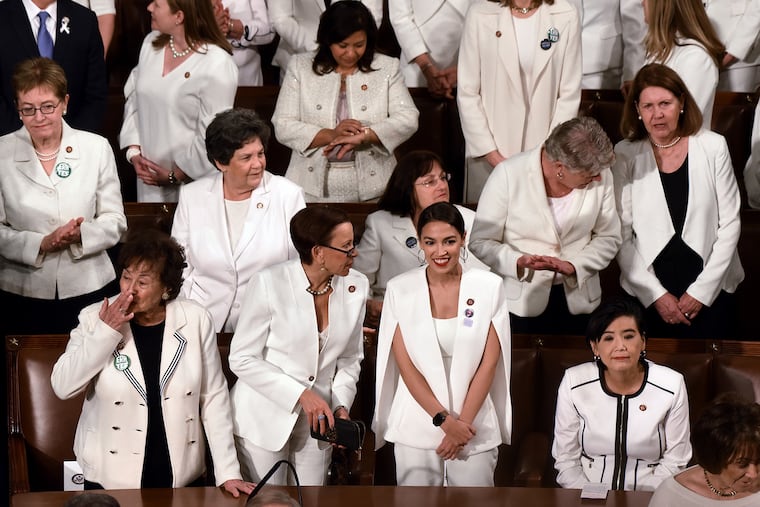State of the Union’s white-wearing congresswomen reminded me of the church-going black women in my family | Elizabeth Wellington
The strength of these politicos reminded me of the faithful women who have stood together for decades in rock solid dignity in black churches all over the world on Sunday mornings.

Most of the women in the U.S. House of Representatives wore all-white ensembles to President Trump’s State of the Union Address Tuesday night to pay homage to suffragists.
Winter be damned.
But the strength of these politicos, from New York Rep. Alexandra Ocasio-Cortez, in her chic pants and matching capelet, to Minnesota Rep. Ilhan Omar, who patriotically layered a white vest over a red, long-sleeved shirt and topped it off with a blue khimar (or headscarf), reminded me of the faithful women who have stood together for decades in rock solid dignity in black churches all over the world on Sunday mornings.
These strong women, especially deaconesses in Baptist congregations and missionaries in African Methodist Episcopal counterparts, have historically stood tall, proud and unmoving in white skirt suits, white hats, white gloves, white shoes and even white pantyhose.
These women — like my paternal grandmother, a deaconess at Shiloh Baptist Church in South Jamaica, Queens during the Civil Rights era through the 1980s — were steadfast presences in their holy worlds where women’s voices were often silenced, not just in the world where many worked hard from early in the morning to late at night as domestics, but within their churches and households, too.
When these women strutted their stuff out in their Sunday-go-to-meeting whites, they just could not be ignored.
“On those first Sundays our white was a sign of unity and solidarity,” said Pauline Moore, the first lady of North Philadelphia’s Tenth Street Baptist Church. Moore watched the State of the Union from her home last night and was also struck by the white clad sisterhood. Her first thought: These are my girls. My people. “We wore white to show how we were connected in our fight against the evil of the world. And all of the women in the church came dressed in white on Women’s Day to show that we were unified. We would not be looked over. Our voices mattered."
Rev. Mark Kelly Tyler’s social media was all abuzz Tuesday night
“I gotta tell you," Tyler, pastor of Mother Bethel AME, said. “My Facebook timeline was was full of, ‘Wow, it looks like an AME annual conference with all of the missionaries sitting down front. It was beautiful.”
“There are so many similarities,” Tyler continued. “Women, like my grandmother, couldn’t be fully ordained into the AME Church until 1960. So what did they do? They lived out their call in the women’s missionary society. In their all white outfits, they exercised leadership.”
Wearing one color from head-to-toe to show solidarity has long been among this country’s visual cues that unity is afoot from the Black Panthers who wore all black, down to their signature berets, to the white hoods of the Ku Klux Klan. In the last two years, we’ve really seem to have taken to going monotone to make strong political and social statements. Take the slew of actresses who walked the 2018 Golden Globes red carpet in every style of black gown, or the red MAGA hats at Trump rallies. This is the third year in a row women in the House decided to take a monochromatic stand. In 2017, they wore all white, and in 2018, they wore all black. But because there were so many freshman Democrats in the House for last night’s speech, the visual impact couldn’t go unnoticed.
There is a common belief that suffragists only wore white, said Angela P. Dodson, the Philadelphia-based author of Remember the Ladies: Celebrating Those Who Fought For Freedom at the Ballot Box (Center Street, 2017), who is also the wife of Michael Days, the Inquirer’s vice president for diversity and inclusion. And while it’s true, the women who so diligently fought for their right to vote in the early 20th century did wear white for parades, they also wore other shades in the name of protest like purples and yellows. The white-suffragism connection was made stronger in 2016 when Hillary Clinton wore all-white to accept the Democratic nomination for president.
But white has always been a color of solidarity within the African American community, Dodson further explained. And the hue is not just limited to the sanctity of Christ on Communion Sundays and Women’s Days. White is also a color closely linked to having financial means — up until the invention of the washing machine, only the well-off could afford to wear a shade that is so hard to keep clean. Wearing white was a sign that we had indeed overcome.
Upper middle class African American women’s organizations like The Links and Jack & Jill traditionally and still wear uninterrupted white at induction ceremonies. Alpha Kappa Alpha sisters — the sorority presidential hopeful Sen. Kamala Harris is a proud member of ― don themselves in all white for the Ivies Beyond the Wall ceremony, that honors late sisters at their funerals. Black folk have a thing for wearing all white at family reunions. And before there was Diner en Blanc, Sean “Diddy” Combs hosted high siddity hip-hop white parties all over the world.
On Tuesday night, however, it was clear these sisters in politics were clearly not there to party. The messaging was so strong, it makes me wonder if the president’s daughter, Tiffany, got the memo too. Whether she was on board or not, the stark white sea of blazers and sheaths, Chanelesque-skirt suits and wide-legged trousers fashionably announced a new day has indeed arrived. This new class of elected officials were claiming their power, much like the women of color who have consistently praised and prayed in church pews. And like these deaconesses and missionaries, they let their style choices speak elegantly for them.
Watch out, Congress.